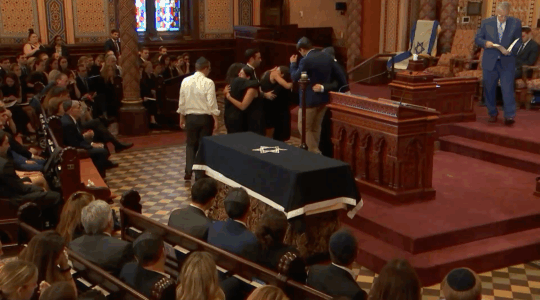When Jan. 1 falls out on a Sunday, calendar reformers crank up the volume a notch, while Sabbath-observant Jews keep cautious watch.
[[READMORE]]
In the waning days of 2011, Johns Hopkins issued a press release touting a “new” calendar proposal. The Hanke-Henry Permanent Calendar proposes a fixed twelve month calendar wherein which each calendar date would heretofore be associated with a particular day of the week; were the calendar to have been adopted in 2012, Jan. 1 would fall on a Sunday this year and all future years.
George Eastman, founder of the Eastman Kodak Company, was also hoping for a new calendar to ring in New Year’s Day 1933 (also a Sunday).
In Sept. 1923, the League of Nations established the Special Committee for the Reform of the Calendar to investigate calendar models that could replace the Gregorian calendar. In 1924, Warsaw was the first Jewish community to express concern with this undertaking, followed closely by other chief rabbis of Europe. While the United States was not a member of the League, Eastman was asked in 1928 by U.S. Secretary of State Frank Kellogg to independently gauge American sentiment towards adopting a new calendar.
Eastman himself favored a calendar proposed by Moses Cotsworth. The Cotsworth calendar had 13-months, each month having 28 days (a thirteenth called “Sol” was situated between June and July) with each date fixed to a particular day of the week. This, according to Eastman, made life easier for commercial enterprises to measure success from month to month. Hence, the Cotsworth model was alternatively known as the “commercial calendar.”
But 28 weeks of 13 days amounts to 364 days: in order to preserve the 365.2422-day cycle of Earth’s orbit around the sun, Cotsworth’s commercial calendar model would need another innovation. Cotsworth decided that the 365th day of each year, Dec. 29, would be called “year-day” and during leap years, June 29 would also be added to the calendar as a leap day. The catch: in order to preserve the perpetual nature of the calendar (e.g. January 1 always beginning on a Sunday), neither of these days would be associated with a day of the week.
“There is nothing sacred about the calendar,” Eastman told Popular Science magazine in 1929. “It has been changed so often that there is no ground for reasonable objection to changing it again.”
But Sabbath-observant groups disagreed.
As the commercial calendar was internally implemented by Kodak, adopted by other business and presented to Congress, JTA reported on the objections of religious organizations. The concerns of Sabbath-observant Jewish organizations were summarized in a presentation to the House of Representatives on Dec. 28, 1928:
Congressman [Sol] Bloom in a chart submitted to the meeting showed the effect the proposed thirteen month year would have on the observance of the Sabbath and Jewish religious life. For instance, the Sabbaths in 1933 would fall on Saturday, while in 1934 they would be shifted to Friday, in 1935 to Thursday, etc. Observant Jews would certainly refuse to accept the new naming of the days and would therefore shift their day of rest one day each year. This would create utter chaos in Jewish religious life and would split up the Jewish people into groups of Jews who worship on different days, Congressman Bloom argued.
In 1929, JTA reported that Jewish organizations “were evidently caught napping” while the U.S. State Department forwarded Eastman’s recommendations to the League of Nations secretary general.
Two years later, a League of Nations committee discussed calendar reform in Geneva. On May 28, 1932 Cotsworth sent the following message to JTA:
Orthodox Rabbis, by insisting upon their congregations observing the Sabbath after sunset hours on the civil Friday until the sunset time on Saturday, are alienating increasing numbers of progressive Jews from their synagogues", and "arousing antagonistic feeling against Jews by such peculiarities which emphasise to all around the refusal of the rabbis to meet the far greater needs of non-Jews, and their failure to recognise the ever-increasing public demand for them to realise that ‘the Sabbath was made for man’ — not man for the Sabbath under conditions existing 3,400 years ago, which were very different from the freedom this generation requires.
In a subsequent address to the League of Nations, Rabbi Dr. Moses Hyamson of New York noted that the American Jewish Committee and the American Jewish Congress — neither Orthodox groups, per se — both opposed the “blank day” calendar endorsed by Cotsworth and Eastman. Furthermore, he argued, other commercial entities had employed internal calendars that do not require the use of blank days:
The great firm of Sears, Roebuck and Company (of which Mr. Julius Rosenwald, the Jewish multi-millionaire philanthropist, is the head) count the first monthly period in the 13 month year as consisting of 29 days. Their mode of procedure is as follows. The First of January, New Year’s Day, they keep as a holiday; they close books and business in all their branches on that day; they open them again on the next day, January the 2nd., and count 364 days to the 31st. of December the end of the year. But they have not adopted the ‘blank day’ device.
Despite the Jewish groups’ tepid approach to calendar reform and explicit rejection of Eastman’s effort, which the League of Nations ultimately dropped, the Nazis in 1936 accused Jews of “trying through the League of Nations to impose calendar reform on Christians and Mohammedans ‘to compel everyone to adjust themselves to the Jewish holidays and to observe an ‘international Shabbes’ (sabbath).’"
The innovation of a universal Sabbath wasn’t unique to Eastman’s preferred calendar and cropped up again in later years.
In 1929, Elisabeth Achelis, a New Yorker of German ancestry, began promoting the 12-month “World Calendar” that similarly featured intercalary days of rest called “Year-End Day” and a “Leap-Year Day” on leap years.
Achelis’s involvement in calendar reform was “based on the belief that it promotes harmony and greater progress in the world and as such exercises a potential influence working for greater international coöperation and amity,” she wrote in an elegantly bound and illustrated family tree published in 1938. Nevertheless, Achelis’ World Calendar was met with opposition from Jewish groups at the U.N. in 1949 and into the 1950s and 1960s.
In preparation for 1939 — the first year after 1933 in which Jan. 1 fell on a Sunday — World Calendar advocates published a World Calendar Almanac, a guide that lists the dates of all 1939 holidays, including Jewish ones.
Sabbath issues notwithstanding, a copy of the Almanac at the New York Public Library shows a number of glitches with respect to the Jewish calendar. For one thing, the Fast of Gedaliah, correctly described by the Almanac as the third of the Jewish month of Tishrei, is incorrectly located twenty days before Yom Kippur, the tenth of Tishrei on the Jewish calendar (although Yom Kippur is correctly listed as Sept. 23, 1939 by the almanac that year.) In another error, the ninth of Av, a fast day, is incorrectly referenced as a ‘feast.’
“A complete synchronization of the Jewish and Moslem calendars with the World Calendar is hardly to be expected without the careful discussion which always precedes calendrical changes,” notes the introduction to the almanac.
While the Hanke-Henry Permanent Calendar (HHPC) is too late to implement in 2012, might it stand a chance in 2017 (the next time Jan. 1 falls out on a Sunday)?
HHPC was profiled by Smithsonian.com on New Year’s Day 2007. Unlike Eastman-Cotsworth and Achelis efforts, HHPC resolves the leap year issue by adding an extra 7-day “leap week” every 5-6 years. In doing so, HHPC adheres to the 7-day cycle of the week while maintaining a permanent calendar.
To the extent that the public is willing to entertain calendar reform, HHPC faces some stiff competition.
Dr. Irv Bromberg, a lecturer at the University of Toronto medical school and an avid calendar enthusiast, has two calendars for consideration by the general public.
The first, Symmetry 454, was profiled by the Wall Street Journal on New Year’s Eve 2009, and stood out for turning February, May, August and November into 35-day months.
A second calendar called Symmetry 010 preserves 30 or 31 day months and, like HHPC, proposes a leap week every 5-6 years. In contrast to HHPC, both of Bromberg’s Symmetry calendars are designed for when Jan. 1 falls on a Monday.
“In comparison with my Symmetry calendars, the HHPC is astronomically less accurate in the long term and has much worse equinox jitter in the medium term,” Bromberg told JTA via email, adding that neither the leap rule nor the arithmetic for HHPC’s calendrical calculations are published.
Another reason Symmetry may possess an edge among Jewish leaders: Bromberg frequently lectures to synagogues and has corresponded with the modern day Sanhedrin society in Israel.
However, Bromberg claims that he isn’t in the business of lobbying for Gregorian calendar reform.
“When I talk to Rabbis, it is about my proposed Hebrew calendar reform ideas, or just generally about the rather poor approximation of the astronomy by the traditional Hebrew calendar,” says Bromberg.
That Hebrew calendar idea? A “future Hebrew calendar” to be implemented in the Jewish year 8001.
“The main difference that Jews might notice,” says Bromberg of his initiative, “is that the 4 out of 19 years that currently have the coldest and wettest Sukkot seasons will instead be observed in their proper time 30 days earlier, when it isn’t so cold and wet.”
JTA has documented Jewish history in real-time for over a century. Keep our journalism strong by joining us in supporting independent, award-winning reporting.





